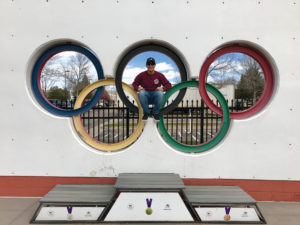 Roman Karadsheh is becoming a familiar face at the Olympic Training Center in Colorado Springs, Colorado.
Roman Karadsheh is becoming a familiar face at the Olympic Training Center in Colorado Springs, Colorado.
For the second year in a row, he will join 180 of the nation’s top marksmen at the 2018 Junior Olympics national competition, from April 6 through April 11.
Mike Costello, an engineer who volunteers his time at the Rio Salado Sportsman’s Club, at Usery Mountain Shooting Range, in East Mesa, coaches the Junior Division program. “Roman has qualified for both the Standing Precision Air Rifle and 3-Position .22 caliber Smallbore competition,” he stated.
Roman has won the 2018 NRA National Junior Sectional Championship and the State of Arizona Civilian Marksmanship Program Championship for Air Rifle. Recently, he took second place in the American Legion National Championship. The junior team traveled to New Mexico, where they took second place in that state championship.
The team also competed at Fort Benning, Georgia, in the U.S. Army Marksmanship Unit National Junior Rifle Championships. “Roman is currently state champion and is ranked in the top 100 nationally,” Coach Costello said. “By the time he is ready to go to college, I expect him to move up in that standing.”
When you meet Roman Karadsheh, an articulate sophomore who attends Red Mountain High School, there is a maturity and calm about him that belies his youth. Roman began learning the discipline of target shooting at age 10. “The discipline of organized marksmanship programs for youth teaches respect and responsibility for firearms, as well as physical and mental control,” Coach Costello stated. “We do this in a very controlled environment where safety education is the No. 1 priority.”
Junior Division Director John Karadsheh has seen how the training has benefited his son. “The discipline of shooting has made a huge change in Roman, helping him gain self-control and focus,” the proud father stated.
The junior program at Rio Salado Sportsman’s Club has produced some of the best marksmen in Arizona. A total of six have earned college scholarships in marksmanship. Roman has his sights set there, as well. When asked if he has Olympic aspirations, he replies, “Right now, the big goal is to shoot in college and to be on a Division I NCAA team.” He already has some ideas about the colleges he would like to attend. There are 18 NCAA Division I universities with men’s rifle teams.
USA Shooting – National Governing Body for Olympic Shooting Sports, and the organization that develops and selects World Cup, Olympics and other international teams, hosts the Junior Olympics. However, unlike the Olympic Games, which are held every four years, Junior Olympics is held every year and attracts marksmen up to 20 years of age from around the country. Competing at national matches like Junior Olympics gives the kids exposure to college coaches who are always on the lookout for up and coming athletes.
For centuries, the skill of marksmanship was a necessity, but gradually grew into a social and recreational pass time. Marksmanship was first introduced in the Olympic Games in 1896. Today, the popularity of the sport engages nearly 20 million Americans who compete in thousands of tournaments each year.
The technology surrounding the sport has advanced significantly with the advent of computerized scoring, which provides immediate feedback to contestants. Technology also has produced apparel that protects and supports the body, while also bringing about high-tech rifle design. The competitive postures remain the same, however. They are standing, kneeling and prone.
To compete in this highly technical sport, marksmen must have good physical control and a great deal of mental concentration. Competitors focus their minds and still their bodies to stay nearly motionless while they fix their aim on a target about the size of a silver dollar. “It is more of a mental game than a physical one,” Roman explained. “Focusing on every shot during a 75-minute match is very mentally taxing. Competing in this sport has developed my mental endurance, and that has helped me in school and life.”
Smallbore competitions test the marksmen’s skills at hitting the 2-inch diameter target at 50 meters in three positions—standing, kneeling and prone—in which 40 shots are fired from each position. The target contains concentric rings with the best score of 10 in the exact middle. A score of 10 means the marksman must hit a spot the size of a typed period from 164 feet away.
In Precision Air Rifle matches, competitors stand 10 meters from the coin-size target holding a 10-pound rifle with their arm precisely braced against the body to fire off 60 shots. Attention to the smallest detail is critical.
Tournaments are held both indoors and outdoors. When competing at indoor ranges, athletes have the luxury of thinking only of perfecting technique. When competing at a range out of doors, marksmen must not only focus on technique and body position, but also must judge how direction and velocity of the wind, the intensity and angle of the light, the mirage and the temperature will impact the trajectory and accuracy of the shot.
The competition at the Junior Olympics will test Roman’s performance. He recognizes that placing would be terrific, but is grateful for the opportunity to compete at that level, which he knows will give him the experience he needs to move to the next level in his sport.
For more information about Rio Salado Sportsman’s Club, located at 3960 N. Usery Pass Road, call (480) 984-9610.

